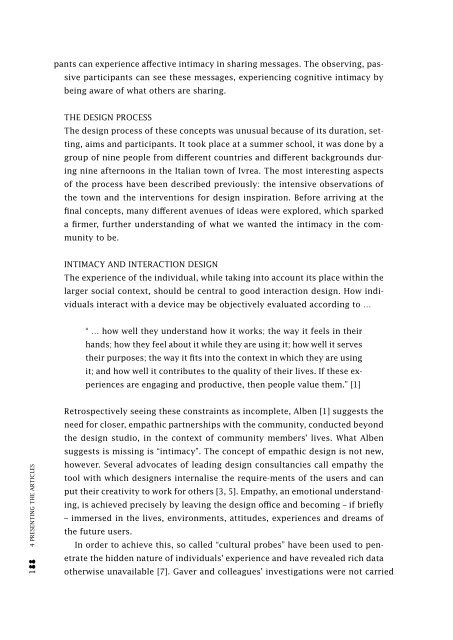Co-experience: Understanding user experiences in social interaction
Co-experience: Understanding user experiences in social interaction
Co-experience: Understanding user experiences in social interaction
You also want an ePaper? Increase the reach of your titles
YUMPU automatically turns print PDFs into web optimized ePapers that Google loves.
pants can <strong>experience</strong> affective <strong>in</strong>timacy <strong>in</strong> shar<strong>in</strong>g messages. The observ<strong>in</strong>g, passive<br />
participants can see these messages, experienc<strong>in</strong>g cognitive <strong>in</strong>timacy by<br />
be<strong>in</strong>g aware of what others are shar<strong>in</strong>g.<br />
THE DESIGN PROCESS<br />
The design process of these concepts was unusual because of its duration, sett<strong>in</strong>g,<br />
aims and participants. It took place at a summer school, it was done by a<br />
group of n<strong>in</strong>e people from different countries and different backgrounds dur<strong>in</strong>g<br />
n<strong>in</strong>e afternoons <strong>in</strong> the Italian town of Ivrea. The most <strong>in</strong>terest<strong>in</strong>g aspects<br />
of the process have been described previously: the <strong>in</strong>tensive observations of<br />
the town and the <strong>in</strong>terventions for design <strong>in</strong>spiration. Before arriv<strong>in</strong>g at the<br />
f<strong>in</strong>al concepts, many different avenues of ideas were explored, which sparked<br />
a firmer, further understand<strong>in</strong>g of what we wanted the <strong>in</strong>timacy <strong>in</strong> the community<br />
to be.<br />
INTIMACY AND INTERACTION DESIGN<br />
The <strong>experience</strong> of the <strong>in</strong>dividual, while tak<strong>in</strong>g <strong>in</strong>to account its place with<strong>in</strong> the<br />
larger <strong>social</strong> context, should be central to good <strong>in</strong>teraction design. How <strong>in</strong>dividuals<br />
<strong>in</strong>teract with a device may be objectively evaluated accord<strong>in</strong>g to …<br />
“ … how well they understand how it works; the way it feels <strong>in</strong> their<br />
hands; how they feel about it while they are us<strong>in</strong>g it; how well it serves<br />
their purposes; the way it fits <strong>in</strong>to the context <strong>in</strong> which they are us<strong>in</strong>g<br />
it; and how well it contributes to the quality of their lives. If these <strong>experience</strong>s<br />
are engag<strong>in</strong>g and productive, then people value them.” [1]<br />
188 4 PRESENTING THE ARTICLES<br />
Retrospectively see<strong>in</strong>g these constra<strong>in</strong>ts as <strong>in</strong>complete, Alben [1] suggests the<br />
need for closer, empathic partnerships with the community, conducted beyond<br />
the design studio, <strong>in</strong> the context of community members’ lives. What Alben<br />
suggests is miss<strong>in</strong>g is “<strong>in</strong>timacy”. The concept of empathic design is not new,<br />
however. Several advocates of lead<strong>in</strong>g design consultancies call empathy the<br />
tool with which designers <strong>in</strong>ternalise the require-ments of the <strong>user</strong>s and can<br />
put their creativity to work for others [3, 5]. Empathy, an emotional understand<strong>in</strong>g,<br />
is achieved precisely by leav<strong>in</strong>g the design office and becom<strong>in</strong>g – if briefly<br />
– immersed <strong>in</strong> the lives, environments, attitudes, <strong>experience</strong>s and dreams of<br />
the future <strong>user</strong>s.<br />
In order to achieve this, so called “cultural probes” have been used to penetrate<br />
the hidden nature of <strong>in</strong>dividuals’ <strong>experience</strong> and have revealed rich data<br />
otherwise unavailable [7]. Gaver and colleagues’ <strong>in</strong>vestigations were not carried

















